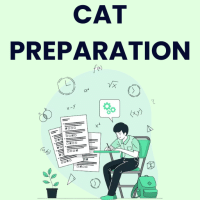CAT Exam > CAT Questions > Instructions: For the following questions ans...
Start Learning for Free
Instructions: For the following questions answer them individually
Four sentences related to a topic are given below. Three of them can be put together to form a meaningful and coherent paragraph. Identify the odd one out.
A. Since birds are the modern descendants of dinosaurs, they are likely to have once had teeth instead of beaks.
B. However, 100 million years ago a diverse range of non-avian dinosaurs spouted all manner of plumage, and like modern birds, doubtless made a great deal of use of them, even if they could not fly.
C. This fact became known way back in 1861 when paleontologists discovered a bird fossil, about 150 million years old, now classified as Archaeopteryx, which had teeth.
D. Researchers have now published details of how avian edentulism occurred in one common bird ancestor more than 100 million years ago.
Four sentences related to a topic are given below. Three of them can be put together to form a meaningful and coherent paragraph. Identify the odd one out.
A. Since birds are the modern descendants of dinosaurs, they are likely to have once had teeth instead of beaks.
B. However, 100 million years ago a diverse range of non-avian dinosaurs spouted all manner of plumage, and like modern birds, doubtless made a great deal of use of them, even if they could not fly.
C. This fact became known way back in 1861 when paleontologists discovered a bird fossil, about 150 million years old, now classified as Archaeopteryx, which had teeth.
D. Researchers have now published details of how avian edentulism occurred in one common bird ancestor more than 100 million years ago.
- a)A
- b)B
- c)C
- d)D
Correct answer is option 'B'. Can you explain this answer?
Most Upvoted Answer
Instructions: For the following questions answer them individuallyFour...
Method of solving this Question from Sentence Elimination:
Sentence A tells us that birds are modern descendants of dinosaurs and hence they are likely to have once had teeth.
Sentence C also talks of teeth, stating that “this fact" became known in 1861 with the discovery of Archaeopteryx, which had teeth. The fact referred to here is the one stated in sentence A, that birds once had teeth. So C follows A.
We now need to find the third sentence that fits in with C and A.
Sentence B says that non-avian dinosaurs sprouted feathers 100 million years ago.
Sentence D declares that researchers have discovered that avian edentulism, or loss of teeth, occurred in one common bird ancestor 100 million years ago.
It is clear that CAD makes a cogent paragraph.
The question is " Choose the Sentence that does not fit in "
Hence, the answer is Sentence B.
Sentence A tells us that birds are modern descendants of dinosaurs and hence they are likely to have once had teeth.
Sentence C also talks of teeth, stating that “this fact" became known in 1861 with the discovery of Archaeopteryx, which had teeth. The fact referred to here is the one stated in sentence A, that birds once had teeth. So C follows A.
We now need to find the third sentence that fits in with C and A.
Sentence B says that non-avian dinosaurs sprouted feathers 100 million years ago.
Sentence D declares that researchers have discovered that avian edentulism, or loss of teeth, occurred in one common bird ancestor 100 million years ago.
It is clear that CAD makes a cogent paragraph.
The question is " Choose the Sentence that does not fit in "
Hence, the answer is Sentence B.

|
Explore Courses for CAT exam
|

|
Question Description
Instructions: For the following questions answer them individuallyFour sentences related to a topic are given below. Three of them can be put together to form a meaningful and coherent paragraph. Identify the odd one out.A. Since birds are the modern descendants of dinosaurs, they are likely to have once had teeth instead of beaks.B. However, 100 million years ago a diverse range of non-avian dinosaurs spouted all manner of plumage, and like modern birds, doubtless made a great deal of use of them, even if they could not fly.C. This fact became known way back in 1861 when paleontologists discovered a bird fossil, about 150 million years old, now classified as Archaeopteryx, which had teeth.D. Researchers have now published details of how avian edentulism occurred in one common bird ancestor more than 100 million years ago.a)Ab)Bc)Cd)DCorrect answer is option 'B'. Can you explain this answer? for CAT 2025 is part of CAT preparation. The Question and answers have been prepared according to the CAT exam syllabus. Information about Instructions: For the following questions answer them individuallyFour sentences related to a topic are given below. Three of them can be put together to form a meaningful and coherent paragraph. Identify the odd one out.A. Since birds are the modern descendants of dinosaurs, they are likely to have once had teeth instead of beaks.B. However, 100 million years ago a diverse range of non-avian dinosaurs spouted all manner of plumage, and like modern birds, doubtless made a great deal of use of them, even if they could not fly.C. This fact became known way back in 1861 when paleontologists discovered a bird fossil, about 150 million years old, now classified as Archaeopteryx, which had teeth.D. Researchers have now published details of how avian edentulism occurred in one common bird ancestor more than 100 million years ago.a)Ab)Bc)Cd)DCorrect answer is option 'B'. Can you explain this answer? covers all topics & solutions for CAT 2025 Exam. Find important definitions, questions, meanings, examples, exercises and tests below for Instructions: For the following questions answer them individuallyFour sentences related to a topic are given below. Three of them can be put together to form a meaningful and coherent paragraph. Identify the odd one out.A. Since birds are the modern descendants of dinosaurs, they are likely to have once had teeth instead of beaks.B. However, 100 million years ago a diverse range of non-avian dinosaurs spouted all manner of plumage, and like modern birds, doubtless made a great deal of use of them, even if they could not fly.C. This fact became known way back in 1861 when paleontologists discovered a bird fossil, about 150 million years old, now classified as Archaeopteryx, which had teeth.D. Researchers have now published details of how avian edentulism occurred in one common bird ancestor more than 100 million years ago.a)Ab)Bc)Cd)DCorrect answer is option 'B'. Can you explain this answer?.
Instructions: For the following questions answer them individuallyFour sentences related to a topic are given below. Three of them can be put together to form a meaningful and coherent paragraph. Identify the odd one out.A. Since birds are the modern descendants of dinosaurs, they are likely to have once had teeth instead of beaks.B. However, 100 million years ago a diverse range of non-avian dinosaurs spouted all manner of plumage, and like modern birds, doubtless made a great deal of use of them, even if they could not fly.C. This fact became known way back in 1861 when paleontologists discovered a bird fossil, about 150 million years old, now classified as Archaeopteryx, which had teeth.D. Researchers have now published details of how avian edentulism occurred in one common bird ancestor more than 100 million years ago.a)Ab)Bc)Cd)DCorrect answer is option 'B'. Can you explain this answer? for CAT 2025 is part of CAT preparation. The Question and answers have been prepared according to the CAT exam syllabus. Information about Instructions: For the following questions answer them individuallyFour sentences related to a topic are given below. Three of them can be put together to form a meaningful and coherent paragraph. Identify the odd one out.A. Since birds are the modern descendants of dinosaurs, they are likely to have once had teeth instead of beaks.B. However, 100 million years ago a diverse range of non-avian dinosaurs spouted all manner of plumage, and like modern birds, doubtless made a great deal of use of them, even if they could not fly.C. This fact became known way back in 1861 when paleontologists discovered a bird fossil, about 150 million years old, now classified as Archaeopteryx, which had teeth.D. Researchers have now published details of how avian edentulism occurred in one common bird ancestor more than 100 million years ago.a)Ab)Bc)Cd)DCorrect answer is option 'B'. Can you explain this answer? covers all topics & solutions for CAT 2025 Exam. Find important definitions, questions, meanings, examples, exercises and tests below for Instructions: For the following questions answer them individuallyFour sentences related to a topic are given below. Three of them can be put together to form a meaningful and coherent paragraph. Identify the odd one out.A. Since birds are the modern descendants of dinosaurs, they are likely to have once had teeth instead of beaks.B. However, 100 million years ago a diverse range of non-avian dinosaurs spouted all manner of plumage, and like modern birds, doubtless made a great deal of use of them, even if they could not fly.C. This fact became known way back in 1861 when paleontologists discovered a bird fossil, about 150 million years old, now classified as Archaeopteryx, which had teeth.D. Researchers have now published details of how avian edentulism occurred in one common bird ancestor more than 100 million years ago.a)Ab)Bc)Cd)DCorrect answer is option 'B'. Can you explain this answer?.
Solutions for Instructions: For the following questions answer them individuallyFour sentences related to a topic are given below. Three of them can be put together to form a meaningful and coherent paragraph. Identify the odd one out.A. Since birds are the modern descendants of dinosaurs, they are likely to have once had teeth instead of beaks.B. However, 100 million years ago a diverse range of non-avian dinosaurs spouted all manner of plumage, and like modern birds, doubtless made a great deal of use of them, even if they could not fly.C. This fact became known way back in 1861 when paleontologists discovered a bird fossil, about 150 million years old, now classified as Archaeopteryx, which had teeth.D. Researchers have now published details of how avian edentulism occurred in one common bird ancestor more than 100 million years ago.a)Ab)Bc)Cd)DCorrect answer is option 'B'. Can you explain this answer? in English & in Hindi are available as part of our courses for CAT.
Download more important topics, notes, lectures and mock test series for CAT Exam by signing up for free.
Here you can find the meaning of Instructions: For the following questions answer them individuallyFour sentences related to a topic are given below. Three of them can be put together to form a meaningful and coherent paragraph. Identify the odd one out.A. Since birds are the modern descendants of dinosaurs, they are likely to have once had teeth instead of beaks.B. However, 100 million years ago a diverse range of non-avian dinosaurs spouted all manner of plumage, and like modern birds, doubtless made a great deal of use of them, even if they could not fly.C. This fact became known way back in 1861 when paleontologists discovered a bird fossil, about 150 million years old, now classified as Archaeopteryx, which had teeth.D. Researchers have now published details of how avian edentulism occurred in one common bird ancestor more than 100 million years ago.a)Ab)Bc)Cd)DCorrect answer is option 'B'. Can you explain this answer? defined & explained in the simplest way possible. Besides giving the explanation of
Instructions: For the following questions answer them individuallyFour sentences related to a topic are given below. Three of them can be put together to form a meaningful and coherent paragraph. Identify the odd one out.A. Since birds are the modern descendants of dinosaurs, they are likely to have once had teeth instead of beaks.B. However, 100 million years ago a diverse range of non-avian dinosaurs spouted all manner of plumage, and like modern birds, doubtless made a great deal of use of them, even if they could not fly.C. This fact became known way back in 1861 when paleontologists discovered a bird fossil, about 150 million years old, now classified as Archaeopteryx, which had teeth.D. Researchers have now published details of how avian edentulism occurred in one common bird ancestor more than 100 million years ago.a)Ab)Bc)Cd)DCorrect answer is option 'B'. Can you explain this answer?, a detailed solution for Instructions: For the following questions answer them individuallyFour sentences related to a topic are given below. Three of them can be put together to form a meaningful and coherent paragraph. Identify the odd one out.A. Since birds are the modern descendants of dinosaurs, they are likely to have once had teeth instead of beaks.B. However, 100 million years ago a diverse range of non-avian dinosaurs spouted all manner of plumage, and like modern birds, doubtless made a great deal of use of them, even if they could not fly.C. This fact became known way back in 1861 when paleontologists discovered a bird fossil, about 150 million years old, now classified as Archaeopteryx, which had teeth.D. Researchers have now published details of how avian edentulism occurred in one common bird ancestor more than 100 million years ago.a)Ab)Bc)Cd)DCorrect answer is option 'B'. Can you explain this answer? has been provided alongside types of Instructions: For the following questions answer them individuallyFour sentences related to a topic are given below. Three of them can be put together to form a meaningful and coherent paragraph. Identify the odd one out.A. Since birds are the modern descendants of dinosaurs, they are likely to have once had teeth instead of beaks.B. However, 100 million years ago a diverse range of non-avian dinosaurs spouted all manner of plumage, and like modern birds, doubtless made a great deal of use of them, even if they could not fly.C. This fact became known way back in 1861 when paleontologists discovered a bird fossil, about 150 million years old, now classified as Archaeopteryx, which had teeth.D. Researchers have now published details of how avian edentulism occurred in one common bird ancestor more than 100 million years ago.a)Ab)Bc)Cd)DCorrect answer is option 'B'. Can you explain this answer? theory, EduRev gives you an
ample number of questions to practice Instructions: For the following questions answer them individuallyFour sentences related to a topic are given below. Three of them can be put together to form a meaningful and coherent paragraph. Identify the odd one out.A. Since birds are the modern descendants of dinosaurs, they are likely to have once had teeth instead of beaks.B. However, 100 million years ago a diverse range of non-avian dinosaurs spouted all manner of plumage, and like modern birds, doubtless made a great deal of use of them, even if they could not fly.C. This fact became known way back in 1861 when paleontologists discovered a bird fossil, about 150 million years old, now classified as Archaeopteryx, which had teeth.D. Researchers have now published details of how avian edentulism occurred in one common bird ancestor more than 100 million years ago.a)Ab)Bc)Cd)DCorrect answer is option 'B'. Can you explain this answer? tests, examples and also practice CAT tests.

|
Explore Courses for CAT exam
|

|
Signup for Free!
Signup to see your scores go up within 7 days! Learn & Practice with 1000+ FREE Notes, Videos & Tests.


















